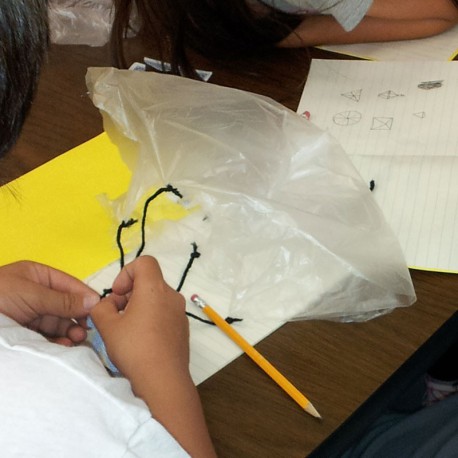 View larger
View larger
Parachute Design
New activity
Celebrate the accomplishment's of the Huygen's probe with this classic, STEM-based activity!
Open Activity
-
Rating
-
Participants Enjoyed the ActivityParticipants Learned from This ActivityActivity Instructions Were Clear and Easy to FollowWould Recommend
Related Programming Resources
| Hints for uses in your library | This activity would work well as an after-school program, with plenty of time for participants to redesign and retest their parachutes. The parachutes should be dropped from an elevated area, such as a staircase or second story balcony. A large drop distance is preferred. Closely supervise students on elevated surfaces at all times. |
| Related Links |
Parachuting to Titan
Ten Years Ago, Hyugens Probe Lands on Surface of Titan Videos from NASA's Capsule Parachute Assembly System (CPAS) project Orion Parachutes Testing a Parachute for NASA 2020 Mars Rover NASA Mars Science Laboratory (Curiosity Rover) Mission Animation |
| Originating Source | NASA/JPL-Caltech |
| Related Books [Suggest a book] |
How Do Parachutes Work? by Jennifer Boothroyd
Spaceships and Rockets by Deborah Lock Rocket Science by Deborah Lock |
Reviews
Very fun activity
This was one of my favorite activities because of the overwhelmingly positive response from the kids. We actually leveled this activity up and used eggs as the payload. Also, we threw the parachutes out the window of the 2nd floor of the library. The kids were definitely engaged!
I did this activity with about 16 kids in grades 3 through 6, a few adult caregivers were present, but some kids were there on their own as well.
I provided the kids with plastic bags of various sizes, string, hole punches, scissors, tape, pencils, and rulers. I also gave them a 3-ounce paper cup along with their egg to use as the payload. The egg was wrapped placed in a baggie, which we called the “flight suit” to minimize any mess, but we didn’t allow for any sort of padding in the cup.
The video included in the activity was engaging and very short, so we started by watching that. We talked a short time about parachute design and I showed them a few different parachutes I had made of different styles. I also introduced the engineering design process and let the kids decide if they would work together or independently. Most wanted to build their own parachute to throw out the window, but they worked together on their designs.
Because we had a bit of a time constraint, we skipped the steps using napkins and went straight for the plastic bags. The kids took about 20 minutes to build their parachute, then we dropped them one at a time out the window. I had adult staff both upstairs at the window and downstairs to collect the parachutes and eggs. The kids took turns standing at the bottom and timing the parachutes, as well as evaluating the damage of the payload. Surprisingly, very few eggs were broken and most of those were because the cup landed on its side and the egg rolled out onto the sidewalk and smashed. Once they saw what was happening, they redesigned their cups to include “seat belts” to hold the egg in the cup after it landed.
We spent about 25 minutes throwing eggs out the window; everyone had the chance to redesign their parachute and try again. The cost of the event was minimal; the only thing I purchased was the eggs and the paper cups because I had everything else on hand. This was a very fun event!
Plenty of opportunity for multiple iterations
Kids could have kept working on this for hours, if uninterrupted. Most produced at least a couple of versions in an hour. I set out tissue paper and multiple styles of trash bags, both of which worked well. For string, we used a spool of thin string, and as another option, embroidery floss. Both were fine. Another time, I might involve the kids in the prep process by having them help brainstorm more materials, especially "found" or waste items.
One of the trickier parts was finding a good weight to suspend. A plastic T. Rex would have been great fun, but weighed too much and would have had to have been passed around. Instead, I settled on the empty cores of our receipt printer rolls. They were a good weight and easily attached, not to mention providing one more use for them before they reached the trash. With a few weeks ' warning, colleagues are likely to inundate you with plenty to spread around a group.
Participants also readily found variables to change for further trials, being eager to try new shapes, materials, string length, and parachute size. This was an activity that left them thinking about the subject matter well after we had put away the supplies.



